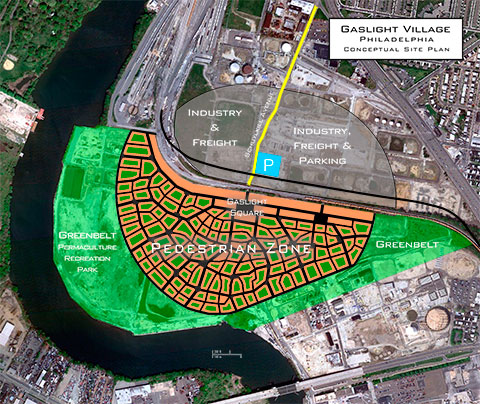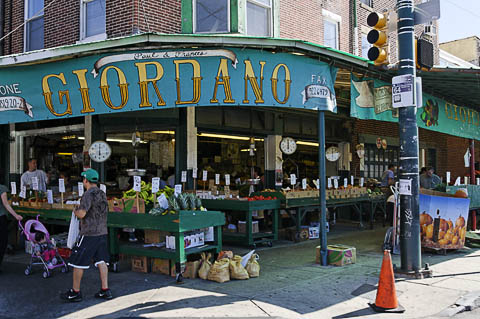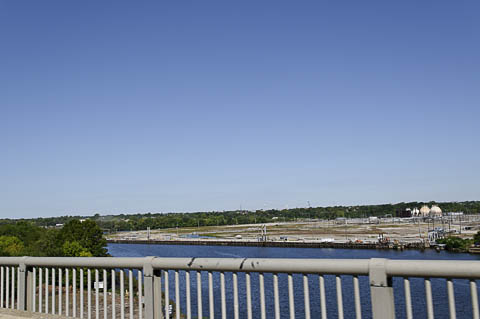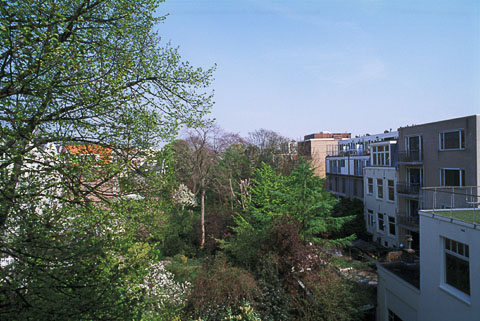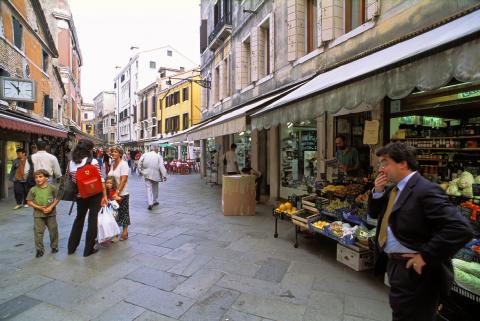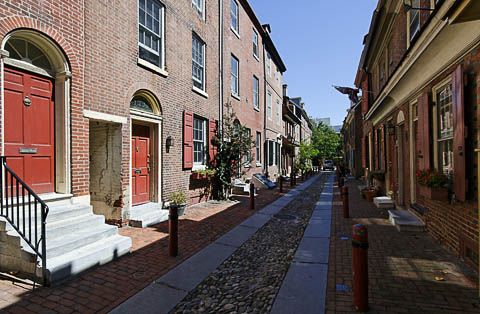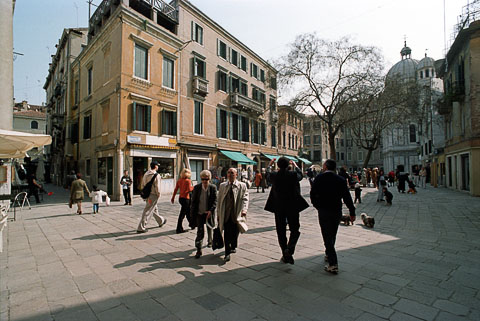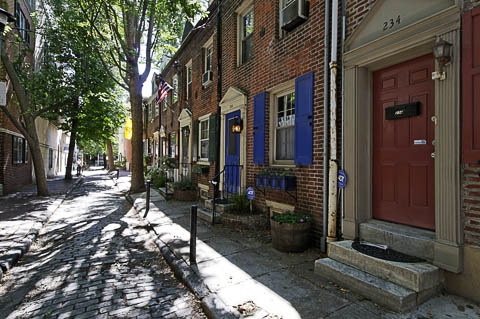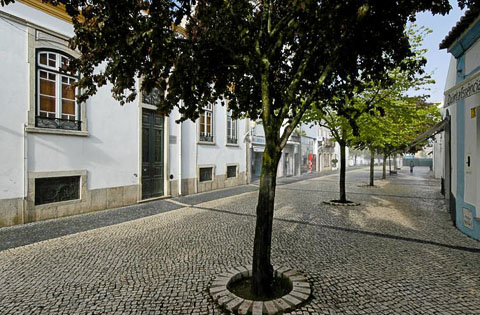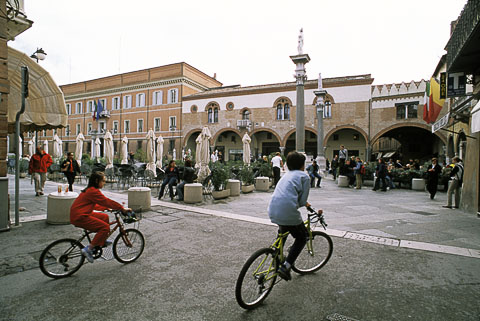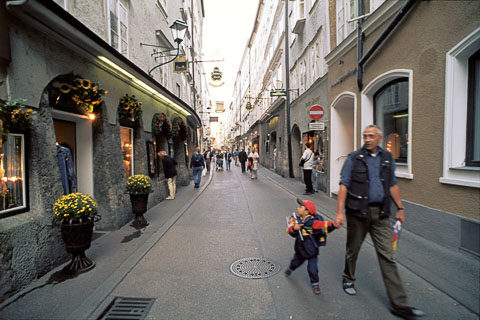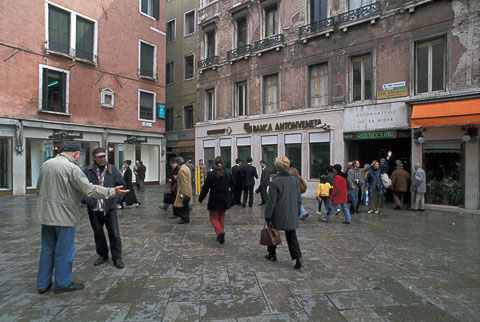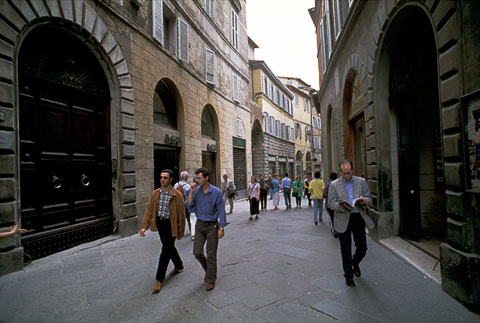
|
||
|
Issue 59 |
|
16 September 2010 |
|
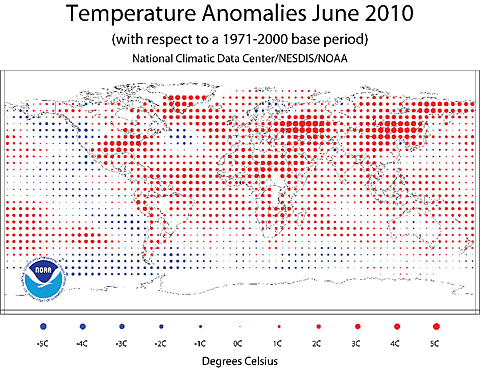 Temperature anomalies for June 2010. Globally, this is the hottest June ever recorded. NOAA image AnnouncementsCarfree District for PhiladelphiaWe are exploring the feasibility of redeveloping a large brownfield site in Philadelphia as a carfree district. The Feature Article in this issue describes the site and our preliminary proposal for it.Digital Photo ArchiveA large photo resource has been added to the Design Library section of Carfree.com. The new images, about 6000 in number, are available at Digital Photographs. The images are freely available for not-for-profit use.The BooksCarfree Cities and Carfree Design Manual are widely available in Europe and North America.World Carfree NetworkCarfree.com actively supports World Carfree Network (WCN). The main news from the network follows.Towards Carfree Cities X to Be Hosted in GuadalajaraJune 2011 will see the first Latin-American edition of Towards Carfree Cities. I met with three of the organizers in York, and they are a committed group intent on doing a version of the conference adapted for a Latin-American audience. Guadalajara is a Mexican city of more than four million people.Prague Office ClosedFinancial difficulties have necessitated the closing of WCN's Prague office. The organization will continue to operate, but the bricks-and-mortar location is gone. An office may be reestablished as circumstances permit. The network is in the process of decentralizing. Most of its functions will continue without interruption. Two hubs are emerging, one in Europe and the other in North America. These will be run by local WCN member organizations.Four core activities are to receive the most attention:
I'm planning the final installment of the Carfree Conversions series of articles that have been running in Carbusters for more than a year. The final article will consider the addition of public squares and the need for accessible green space. World Carfree DayAs it is every year, World Carfree Day will be observed around the world on 22 September. The WCN website offers campaign resources andWorld Carfree Day is associated with European Mobility Week 2010, a week-long event throughout Europe. Over 1400 cities have registered. The dates are 16-22 September. 10/10/10350.org, the brainchild of Bill McKibben, is not directly affiliated with WCN, but its activities are in keeping with WCN's objectives. 10/10/10 is an event that will be observed around the globe on 10 October 2010. The goal is to begin immediately to reduce greenhouse gas emissions worldwide. It's not too late to join this crucial effort.
|
News Bits Temperature anomalies for June 2010 Red indicates hotter than normal. NOAA Hottest JuneJune was the hottest June ever recorded worldwide and the fourth consecutive month that the combined global land and sea temperature records have been broken. The summer continued exceptionally hot in many places, with frightening forest fires in Russia. Here in the New York City area, temperatures broke 90°F (32°C) nearly every day in July. Nights were also exceptionally hot, and it was unusually dry. Figures released by NOAA suggest that 2010 is on course to be the warmest year since recordkeeping began in 1880.The trend towards a warmer world is now almost impossible to ignore. NOAA said that June was the 304th consecutive month with a combined global land and surface temperature above the 20th-century average. (That's all of the past 25 years.) The picture is not uniform, of course, and some places had cooler-than-normal temperatures. For the most part, these were not all that much below normal, whereas Asia, North America, and Greenland saw temperatures far above normal. Satellite data from the US National Snow and Ice Data Center showed that the extent of sea ice in the Arctic was at its lowest for any June since satellite observations began in 1979. The remaining ice is also thinner than it normally is. In July, a huge iceberg calved off the Jakobshavn Glacier. It was one of the largest single losses to a glacier ever seen.
"Last month was the hottest June recorded worldwide, figures show Fires Fuel Russian Concerns About Global WarmingRussian President Dmitry Medvedev had recently downplayed concerns about global warming. Then Russia caught fire, and he changed his tune. Russia was hit this summer by the worst forest fires on record. The fires were stoked by unprecedented heat and drought (see article above). Moscow was blanketed in thick, toxic smoke for a week. So was a huge swathe of western Russia.Russian officials, fearing for the nation's economic growth, had stonewalled on climate issues for years. Now they get the picture. Medvedev said: Everyone is talking about climate change now. Unfortunately, what is happening now in our central regions is evidence of this global climate change, because we have never in our history faced such weather conditions in the past. This means that we need to change the way we work, change the methods that we used in the past.Russia had been forecasting a 30% growth in the rate of CO2 emissions by 2020. That may now change. Previously, Russian leaders had suggested that climate change might work to Russia's benefit by easing access to natural resources in the far north or by opening the Northeast Passage to shipping. However, Nikolai Petrov of the Carnegie Center in Moscow thought that the traditional laxity of Russian officials will probably overcome any impulse to take long-term measures once the present crisis has abated. He said that a cautionary precedent was what happened after the peat bogs around Moscow burned in 1972, suffocating the city under a blanket of heavy smoke for days. Soviet authorities then acknowledged that the policy of draining marshes in order to harvest peat for fuel was to blame. They pledged to avoid a repetition. "Those same peat bogs are burning today, with the same terrible consequences, because Soviet leaders let it go," he said. He continued, Although the problem in 1972 was relatively simple and easily solvable, they set it aside as soon as the immediate trouble passed. Today the threat is long-term and complex, and it will require major policy and behavioral changes. I wouldn't bet that this change of official mood will last long.Alas, not only Russia suffers from myopia on the subject of climate change.
"Russian fires prompt Kremlin to abruptly embrace climate change" Oceans Dying?The population of phytoplankton is declining. This is very bad news, because the oceanic food chain is largely based on these minute organisms. The decline is not small, either: it's 40% since 1950. The decline is attributed to rising ocean temperatures caused by global warming.An article in the prestigious journal Nature brought attention to the decline. Data for the past century was studied. Phytoplankton are microscopic, plant-like organisms that live in the surface waters of the world's oceans. Between 1899 and 2008, their abundance declined by roughly 1% per year. That works out to a 40% drop since 1950. The trend becomes most pronounced near the poles and in the tropics since 1950. Phytoplankton is vital for its role in taking up the CO2 emitted by burning fossil fuels. Phytoplankton converts CO2 to oxygen and sugars and is the base of the oceanic food chain. Some estimates credit phytoplankton for half of all the photosynthetic activity on Earth. The marine scientists from Dalhousie University in Halifax, NS, who conducted the study call the long-term trend "unequivocal." The size of the change "is staggering," said Daniel Boyce, the lead author. He began the study three years ago as part of a larger effort to explore the factors accounting for declining fish stocks. Overfishing is an obvious cause, but changes at the bottom of the food chain may also play a role. Warming surface waters have prevented deeper, nutrient-laden waters from mixing upward to feed phytoplankton at the surface. The results must still be checked by other researchers, and the available data is rather thin, but the first researchers were diligent in trying to find errors in their method. This is a change of monumental proportions.
"Vital ocean phytoplankton a casualty of global warming?" Conservatives and Transport PolicyUS Republican officeholders hate public transport and love highways. They would in any case never take the bus themselves. Maybe the train. So claims a recent article in The American Conservative.In fact increasing numbers of conservatives are using commuter rail systems. They hate being stuck in traffic just as much as anyone. Conservatives still scream about transit subsidies, preferring to ignore the 42% of highway costs paid out of general revenues. They like to imagine that America's auto-centric landscape is an outcome of market forces. This simply isn't the case. Back a century ago, nearly all decent transport service in the USA was on rails. Most systems were privately owned, paid taxes, and made a profit at least some of the time. Then these systems were gradually wiped out by massive government subsidies to highways. Today's "drive or die" circumstance is a product of a century of government intervention in the transportation market. Comparatively small urban rail projects can yield big returns in the form of private funding for downtown redevelopment. But Buses have no such effect on development because a bus line can be here today, gone tomorrow. The investment in track and overhead wires streetcars and Light Rail require tells developers the service will be there for years to come.That's something I might have said myself. Conservatives pay at least lip service to energy independence. "One of the Bush administration's objectives in invading Iraq was to secure a major new source of oil; predictably, we got war but no oil." A more interesting question is what a thoughtful conservative position on transit might be.So, what has the USA done in the years since Carter left office? Increase its dependence on imported oil. And increase its total consumption. Prudence suggests the first goal of a conservative transportation policy would be to provide options, ways to get around without a car.Then we come to this shocker: For cities, conservatives' banner should read, "Bring Back the Streetcars!" It is no coincidence that the decline of America's cities accelerated when streetcars were replaced by buses. People like riding streetcars, while few like riding buses. Streetcars are "pedestrian facilitators." It is easy to hop off, shop and have lunch, then get on the streetcar again when feet get tired. Pedestrians are the lifeblood of cities; it is no accident that the first three chapters of Jane Jacobs's great book The Death and Life of Great American Cities are about sidewalks.Imagine a conservative quoting Jane Jacobs! (She moved to Toronto, where they have socialized medicine.) The article goes on to call for a restoration of interurban service, which all but disappeared by the 1950s. It also foresees a revival of night boats sailing the Great Lakes and major rivers. (That's not something I'd bet on.) One point conservatives should insist on in reviving our trains, streetcars, and interurbans is keeping costs down. The greatest threat to a revival of attractive public transportation is not the libertarian transit critics. It is an unnecessary escalation of construction costs, usually driven by consultants who know nothing of rail and traction history, are often in cahoots with the suppliers, and gold-plate everything. Overbuilding is omnipresent; some Light Rail lines (the current term for interurbans) look as if they were designed for the Shinkansen. We are now seeing construction cost figures for streetcar lines of $40 million per mile and for light rail sometimes of more than $100 million.When I worked in the rail industry, the cost of just about everything shocked me. This article might have been written by any one of a number of "leftist" thinkers on public transport. But it came from the right. Maybe things really are changing. Can we expect the seed money for Gaslight Village to come from Glenn Beck? Better not hold your breath.
"What's so conservative about federal highways?" Transit & JobsIf the 20 largest metropolitan areas in the USA shifted half of their highway funds to transit, they would generate 180,150 new jobs over five years, without one additional dollar in new spending. This finding is reported by Transportation Equity Network. St. Louis, which currently spends 15% of its TIP funds on public transport, would see a 259% increase in the number of transit jobs, for a net gain of 43,000 jobs. The figures include the jobs lost when highway projects are cut.For more information, read the complete report here.
"More Transit = More Jobs: New Report" Getting Rich on Mixed-Use AreasLocal property-tax data in Sarasota yielded up a recent surprise. WalMarts generate only slightly more tax per acre of land than single-family residential areas. However, a high-rise mixed-use development paid 100 times as much tax per acre as big box stores. Even low-rise residential-over-commercial buildings yield three times as much tax revenue per acre as the richest mall in the area.And it gets even better. The payback period, in tax revenue, for infrastructure costs is only 3 years for a mixed-used condominium building in downtown. Compare that to the residential portion of a multi-use development out at the highway interchange: it's 42 years. The benefits of downtown development compared to auto-centric greenfield development are huge, and people are starting to understand that. It's not only taxes and infrastructure costs, it's carbon footprint, public health, and quality of life. Why would you approve a WalMart in your town?
"Multi-Use Downtown Development Puts Standard Malls' Tax Yield to Shame" Portugal Goes GreenFive years ago, Portuguese leaders adopted a plan to wean the nation away from fossil fuels, nearly all imported, by building facilities to harvest the country's rich renewable energy sources. Today, nearly 45% of electricity used in Portugal is from renewable sources. The IEA recently called land-based wind power "potentially competitive" with fossil fuels. Portugal's capacity has recently increased sevenfold. Prime Minister Joseé Sócrates said, "I've seen all the smiles - you know: It's a good dream. It can't compete. It's too expensive." He recalled how Silvio Berlusconi had mockingly offered to build him an electric Ferrari. He said that Portugal's experience has shown that massive changes in energy supply can be implemented in a remarkably short time. Portuguese households have long paid roughly twice what Americans pay for electricity, but Portugal's electricity costs are approximately average for Europe. Prices have risen a further 15% in the last five years, in part because of the renewable energy program. The IEA called Portugal's renewable energy transition a "remarkable success," but it added, "It is not fully clear that their costs, both financial and economic, as well as their impact on final consumer energy prices, are well understood and appreciated." In fact, what is not clear is how artificially low electricity prices in the USA can be sustained. If the costs, in terms of global warming and toxic emissions, are included, then America's coal-fired utilities probably produce the world's most expensive electricity. Americans simply don't have pay for it. The original article is well worth reading for those with a deep interest in the subject.
"Portugal Gives Itself a Clean-Energy Makeover" Feature Article
Gaslight Village Conceptual Plan Gaslight VillageThe Main IdeaGaslight Village is a proposed mixed-use, pedestrian-oriented, urban village on the site of a former gas works on the east bank of Philadelphia's Schuylkill River. When completed, it will be home to some 4,000 families.
One of Philadelphia's street markets Shopping, businesses, social, educational, recreational, and community activities will be clustered around Gaslight Square, at the heart of the village and close to the transport hub. A variety of sustainable industries will provide local employment for many residents of Gaslight Village. The district will not be entirely self-contained, but nearly all requirements of daily life will be located within it.
The site, seen from Passyunk Avenue Bridge Location, Shape, and SizeThe site is located in South Philadelphia at the former Municipal Gas Works. The site is served by a single road and a heavy-rail freight railroad that passes through the middle of the site. Overall, the village and the adjacent industrial zone occupy a rough ellipse almost a mile long and nearly 3000 feet wide. The site occupies about 220 acres. The site is divided into two major parts by the rail line. The southern part will be a mixed-use district containing everything except "utility" functions such as freight handling, parking, trash processing, warehousing, and manufacturing. Utility functions will be located on the north side of the rail line and served by both road and rail freight. A parking garage and the central transport station will also be located north of the rail line, near the main entrance to Gaslight Square. Also situated in the garage will be car-sharing facilities and a baggage handling operation. Streets in the pedestrian zone will be accessible to emergency service vehicles. The site will be linked by rail to SEPTA's Market-Frankford Line, with convenient transfer to SEPTA trolley and regional rail services, and to Amtrak at 30th Street Station. The site is linked to the Grays Ferry community via Schuylkill Avenue, and other South Philadelphia neighborhoods are just across the Schuylkill Expressway and will be accessible by extensions of existing SEPTA bus routes. Green SpaceMuch of the southern part of the district will be surrounded by green space, some of it devoted to parklands and playing fields. The greenbelt will be situated between the Schuylkill River and the southern edge of the pedestrian district. Most of the greenbelt will be more than 600 feet wide. Some of this area may be dedicated to "permaculture," a form of high-yield, sustainable agriculture that would provide appreciable amounts of food and significant employment.
Amsterdam Courtyard Nearly all blocks will have spacious interior courtyards that will provide green space adjacent to most buildings. These courtyards will average 100 by 150 feet. Most of them will be planted with trees to provide shade and a degree of privacy. Why is Gaslight Village Needed?Like most other northeastern industrial cities, Philadelphia suffered after WWII from rapid suburban growth and the hollowing-out of the urban core. This caused serious urban problems and created a sprawling suburban form based on intensive automobile use. This arrangement probably cannot be sustained in the face of peak oil, climate change, and economic constraints. The city has lost much of the opportunity that once characterized life there, along with nearly a quarter of its population. Those who are left behind, except for a few living in gentrified pockets, have fewer and poorer choices of work, schools, health care, recreation, and culture. Personal safety and security have declined significantly. Over the past 50 years, many attempts have been made to revitalize Philadelphia's neighborhoods, but few have had lasting positive effect. The pedestrian village model offers a cost-effective, efficient, and attractive way to integrate the people of the community with the jobs, goods, and services they need and with the amenities that make urban living an attractive alternative to the suburbs.
Venice Street Scene Village CharacterGaslight Village will blend the best of 18th and 19th century Philadelphia tradition with the most efficient and sustainable technologies of the 21st century. Iconic images of Philadelphia's old streets are familiar to people around the world. These are beautiful, human-scaled places with narrow streets and small three-story buildings. These buildings are usually of traditional brick construction, which is economical to maintain, fireproof, durable, and beautiful.
Elfreth's Alley, Philadelphia Gaslight Square, the new community's center, may resemble Independence Hall but will incorporate solar heating and electricity generation, advanced insulation practices, and teleconferencing facilities. Local offices, shops, and services will provide the goods and services of daily life within easy walking distance of home, without the need to drive or even take transit. Biking will also be well supported, and the streets will be amply wide for both pedestrians and cyclists.
Daily Life in Venice Local businesses will be supplied through the industrial area, with excellent access to both rail freight and trucking, largely eliminating the need to move heavy freight through the community's streets. A walk through the streets of Gaslight Village will reveal much in common with Society Hill, Queen Village, or Elfreth's Alley, but people won't have to compete with cars for space in our streets. Children will play safely while adults relax in the tranquil atmosphere of their local streets and squares.
South Hutchinson St., Philadelphia Typical buildings will be of brick construction, from 2½ to 4 stories in height, sharing walls with their neighbors, as is traditional in Philadelphia townhouses. This arrangement greatly reduces the exposed wall surface, with corresponding reductions in heating and cooling loads. Nearly all buildings will enjoy generous interior courtyards, immediately adjacent to the backs of the houses.
Tree-Lined Narrow Street in Portugal A wide swath of green space will sweep around the district from the west, across the south, and on to the east, ending at the railroad tracks. A variety of green uses, including playing fields, a waterfront promenade, parkland, community gardens, and permaculture will be situated in the green belt. Further green will be provided by shade trees in most streets. A vital characteristic of communities such as we propose is tight social bonding within the community. This can still be seen in some Philadelphia neighborhoods, but in other neighborhoods it has largely disappeared, to be replaced by fear and suspicion. We view the fostering of a healthy community as one of the greatest benefits Gaslight Village will offer. This will be a huge improvement in the quality of life for many of the people who will move there. We expect diverse, mutually-supportive communities to arise once an attractive and safe stage for community life is provided in the human-scaled streets free of the noise and danger of cars. EconomicsHow will we pay for this? Feasibility studies will require a comparatively modest grant from a foundation committed to demonstrating state-of-the-art sustainable urbanism. Once the project is under way, we can anticipate remediation assistance from federal, state, and local agencies to clean up toxic material from the former gas works. Umbrella financing packages will be arranged for core industrial startups and Gaslight Square commercial/residential construction to ensure that the initial critical mass of people and business is achieved. We anticipate that once the character of this remarkable community becomes familiar to Philadelphians there will be considerable demand for building sites in the remainder of Gaslight Village. Ongoing financing for the rest of the build-out would come from traditional sources on a project-by-project basis. We expect this to be self-organizing because the economics are compelling: floor-area and per-capita costs should be much lower than comparable suburban development. At the same time, Gaslight Village should enjoy a quality of life far better than is the norm in any American city today.
Biking in Ravenna, Italy Local stores become economically viable because they need allocate no land for parking lots. Most stores will be located on the ground floors of buildings that have residences on the upper floors. Offices may be situated on the ground floors of buildings more distant from Gaslight Square. This makes highly efficient use of the valuable ground floor locations while providing economical housing above. This is an age-old pattern that still used in most of Europe, much of New York City, and some parts of Philadelphia even today. Gaslight Village is not a gentrification project. Real city neighborhoods are enriched by the presence of residents and workers from all walks of life and of diverse ethnic and cultural backgrounds. It is our intention to help create a community that welcomes all and provides opportunities across the economic spectrum. We anticipate an appreciable demand for labor to clean up toxic waste at the old gas works site. This will provide initial employment at the site, even before any housing is constructed. We expect that the sizable industrial area situated on the north side of the tracks will host a variety of prosperous industries, most of which will address the need for increased sustainability in all of life's activities. These industries tend to be labor intensive, which assures a supply of jobs for the residents of the village. EnergyMedium-density construction in the manner proposed for the village is intrinsically energy efficient. Transport energy will probably be reduced ten-fold. Most of the transport that is not human-powered will be efficient rail or bus service. Initially this will probably be diesel powered, but more sustainable vehicles can be introduced as they become available. Other energy consumption, principally in the form of space heating and cooling, will be reduced by 50% or more compared to typical American usage. Of course, air pollution emissions should be correspondingly reduced. Energy efficiency will also be improved by better freight transport. The site will be arranged to support rail transport in preference to trucks. Container use will be facilitated, and we anticipate direct delivery of containers to a long line of buildings immediately south of the tracks. These would be the active warehouses of the village and also home to stores selling bulky and heavy items. We anticipate that this arrangement will support a trend away from road freight in the coming decades, spurred by the inherent efficiency of rail transport.
Strolling in Salzburg, Austria Within Gaslight Village, most freight will move on pallet movers, freight bikes, and hand carts. The distances are short, so these modes can be employed with relative economy, and the peaceful life on the streets will be minimally disrupted by freight movement. A few exceptions for the entry of trucks may be required, but a hefty fee for truck entry would discourage this. SustainabiltyIt is not yet possible to build a sustainable city, but Gaslight Village moves as close to that goal as can currently be achieved and probably does not conflict with future requirements that may emerge. The design model intrinsically provides vastly reduced energy consumption. We propose to establish some core industries that we expect to grow in the decades ahead as energy and materials shortages increasingly afflict the global economy. We foresee industries to reclaim materials from the waste stream and make useful goods from them. For example, wood in the waste stream would be recovered and reworked to remove metal objects before being laminated into new, durable solid-wood planks that can be used for many purposes. This recovered wood could become the feed stock for a furniture industry producing goods that can be expected to last decades, not years as is the case with fiberboard furniture now so widely produced and frequently discarded.
Campo San Bartolomeo, Venice These changes also ameliorate the problems with solid waste disposal that are becoming ever more serious as available landfill sites move farther and farther away from cities. At the same time, valuable resources, particularly metals, will be recovered and reused or recycled. The reductions in mineral ore excavation and refining alone are sufficient to justify this approach.
Siena, Italy SecurityUrban neighborhoods of the type we propose are inherently crime-resistant. They provide safety and security advantages compared to other models, both urban and suburban. The chief improvement comes from the fact that all areas are occupied both night and day, providing a dense network of human security: eyes on the street. That combined with the stronger community ties that we anticipate will help to keep people safe on the streets. Furthermore, criminals will not be able to use cars to mask their identities or for a quick getaway. Join UsThe Gaslight Village Symposium is currently organizing core groups, with the following goals:
If you find the possibilities discussed here intriguing, please join us in formulating plans for bringing them to fruition. Join the Gaslight Village Symposium. Listen to the New Colonist Podcast interview about Gaslight Village.
BooksA CorrectionIn the last issue, I reviewed Charles Siegel's Unplanning: Livable Cities and Political Choices. Mr. Siegel subsequently contacted me regarding the review. It's not usual to respond to an author's criticism of a review, but in this case it's warranted. I read the book early in the summer when I obviously still was not functioning very well. The review has a couple of serious lapses.The book begins with a discussion of the evolution of urban planning during the past 120 years or so. I neglected to discuss this, despite its importance to the theme of the book. Siegel's treatment of this history may be useful to many people, and it's much shorter than Peter Hall's mammoth Cities of Tomorrow. I stated: "Siegel's 'Pedestrian-Oriented City' is not actually carfree but is certainly walkable." Well, in fact he said: As the first ideal type, consider a metropolitan area that banned cars and other personal motor vehicles. . . .This model of urbanism is counterbalanced by a form that I prefer: But if people preferred more urban neighborhoods, any of these three limits on automobile use would lead to a higher density city. Instead of the density of a streetcar suburb, the first model could give us the density of a traditional European city - but without the cars - if people chose to live at that sort of urban density.My own belief is that carfree cities work best at higher densities, because everything is closer to everything else. The transport problem solves itself to a considerable degree.
Hot New LinksThe links below will open in a new browser window:
City Places for City People at the New Colonist ""It's Not Practical" in the New Colonist Class Struggle against Car Domination on MR Zine Reducing or eliminating parking in support of TDM initiatives from Transport Canada Green New Deal at NEF Paved with gold: The real value of good street design [PDF!] from CABE Does money grow on trees? [PDF!] a study of urban green from CABE
About Carfree TimesNext IssueThe next issue of Carfree Times is scheduled for December 2010.
Subscribe to Carfree TimesCarfree Times is published quarterly at Carfree.com. To receive e-mail notices of new issues, please visit the subscription page or send e-mail with the word "Subscribe" in the subject line. We do not share our mailing list.Write for Carfree TimesInterested in writing for Carfree Times? We welcome articles on a wide variety of subjects and offer an opportunity to publish letters to the editor and guest editorials. Drop us an e-mail.
|
| Editor | J.H. Crawford |
| Send e-mail | |
| URL | http://www.carfree.com/
|
Back to Carfree.com
Carfree Times Home
Back to Carfree Times Issue 58
Forward to Carfree Times Issue 60
E-mail
carfree.com
Copyright ©2010 J.Crawford
